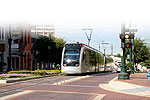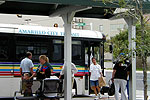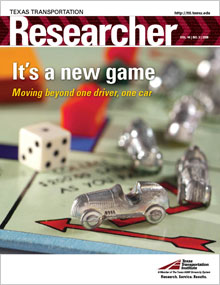TTI compares effectiveness of TDM programs

Have you ever abandoned your SOV in order to use a vanpool and then taken a GRH provided by a TMA? If you don’t know these terms, then you’re probably not one of the many travelers that have decided to share a ride with others. However, you may have been targeted by a transportation demand management (TDM) program to do just that. And the success rates of those kinds of programs can be tricky to evaluate.
TDM programs manage congestion by reducing the number of vehicles on area highways, while maintaining mobility for residents, employees, students and visitors. TDM programs encourage travelers to use options other than the one driver, one car scenario. The biggest advantages to these other modes of transportation are less congestion and thus less air quality problems.
“Most agencies don’t have information on how well their programs are doing,” explains David Ungemah, an associate research scientist with the Texas Transportation Institute (TTI). “To get good data, they need to survey SOV [single-occupant vehicle] use before and after the implementation of the program to measure its impact: how did participants utilize modes after the campaign?”

TTI is currently evaluating TDM programs for a number of sponsors. A project for the Arizona Department of Transportation (ADOT) is benchmarking its region’s TDM efforts against those of peer cities to evaluate how they’re working and what else the agency could be doing. TTI is modeling packages of TDM strategies for the Texas Department of Transportation Austin District and determining how those strategies could be applied to the Austin area’s Commute Solutions program. A project for the Houston-Galveston Area Council is just getting started; TTI will be conducting a thorough review of its TDM program and evaluating program performance.
TTI researchers are also conducting a comprehensive, nationwide survey of all regional or subregional TDM programs. Transportation management associations (TMAs) are generally the organizations responsible for TDM efforts, and researchers are looking at most large and medium urban area TMAs, along with those in some rural areas. They’ve found that projects funded from the Congestion Mitigation and Air Quality (CMAQ) Improvement Program tend to do a better job of monitoring and reporting their performance because of the competitive process of distributing funds. CMAQ usually requires estimates of what the program will do and the results of the program’s impact.

“Even in CMAQ, the methodologies are not always consistent or robust,” says Ungemah. “Some areas, such as Atlanta, Georgia, and Washington, D.C., have set a higher bar for methodology.”
TTI researchers are hoping to show sponsors how to improve their TDM programs and quantify that improvement. It may ultimately come down to resource allocation. “If they want to designate services for TDM, they need to quantify the benefits,” says Ungemah. “The only way to determine that is to have estimates and historical information on the return on investment.”
By adopting methodologies that are sound and robust, it may be easier to ask decision makers to invest in TDM strategies, rather than more concrete investments like further infrastructure.
“What we want to uncover is which programs have been objectively evaluated,” says Dianne Kresich, ADOT’s manager on the TDM project. “What areas have programs that we can say with confidence have quantifiable results and are cost effective? We need this information so we can direct scarce funds to those programs that have an actual impact on reducing SOV use.”
Case studies of TDM programs in five urban areas
TDM strategies encourage using alternatives to SOVs. TTI researchers conducted case studies of three large-sized urban and two medium-sized urban areas. Here are some examples of the strategies used in these areas.
ATLANTA, GEORGIA, provides programs for employers and employees to promote non-SOV commute trips, matches riders together for carpools and vanpools, provides bus and rail transit, has a guaranteed ride home (GRH) program (providing emergency transportation to commuters using alternative modes), offers benefits for commuters who use alternatives to SOVs, and has multiple HOV lanes.
HOUSTON, TEXAS, promotes alternative modes, has a public education program focusing on the health hazards of emissions, provides carpool and vanpool matching, promotes telework, provides bus and rail transit, has a GHR program, offers commuter benefits for carpools and vanpools, and has multiple HOV and managed lanes.
SEATTLE, WASHINGTON, provides carpool and vanpool matching, offers bus and rail transit, has a GRH program, offers benefits for commuters who use alternatives to SOVs, and promotes telework.
AUSTIN, TEXAS, promotes the advantages of alternative modes to employees and employers, provides carpool and vanpool matching, provides training to employers to help them promote carpooling, vanpooling and telecommuting, offers bus and vanpool transit, will soon provide rail transit, and has a GRH program.
RALEIGH-DURHAM, NORTH CAROLINA, promotes alternative modes, provides rideshare matching, offers bus and vanpool transit, and offers benefits for commuters who purchase homes close to work or near a useable transit stop.
